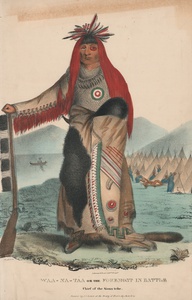| Method | Lithograph with hand colouring |
| Artist | after James Otto Lewis |
| Published | Philadelphia Published Jany. 1836. Lithograph'd by Lehman and Duval No.7 Bank Alley Philadelphia. |
| Dimensions | Image 330 x 248 mm, Sheet 387 x 248 mm |
| Notes |
A full length portrait of Waa-Na-Taa or The Foremost in Battle, the Chief of the Sioux tribe from James Otto Lewis' important work The aboriginal port folio: or, a collection of portraits of the most celebrated chiefs of the North American Indians published in 1836. The portrait shows Waa-Na-Taa standing forward facing the viewer. He wears a buffalo skin ornamented with dyed porcupine quills and on his head he wears a plume of feathers, from which hang strands of dyed red horse hair. In his right hand he holds a gun, decorated with feathers and in his left he holds up his highly decorated cloak and a fan made of horse hair. He wears moccasins, which have foxes tails attached to them. In the background is a scene showing rows of wigwams, a figure in a boat on the water, and mountains in the background. This portrait was taken by Lewis at the Treaty of Prairie du Chien in 1825, a series of peace treaties that were made and signed in Prairie du Chien, now in modern day Wisconsin, between the United States and representatives from the Sioux, Sac and Fox, Menominee, Iowa, Ho-Chunk and the Anishinaabeg (Ojibwe, Odawa and Potawatomi) Native American peoples. The aboriginal port folio: or, a collection of portraits of the most celebrated chiefs of the North American Indians published in parts between 1835-36 is the first printed publication on American Indians originally issued monthly with 8 plates in each instalment. The issues were not popular however, and the publishers ran in to financial difficulties before completing the series. Because of this the series is incredibly rare and rarely seen complete. The drawings and original paintings were done by Lewis during the series of treaty meetings in the Upper Great Lakes region during the 1820's. Lewis was employed and commissioned for fifteen years by the Federal Government as a working artist, working primarily in Wisconsin and Indiana, where he painted portraits and scenes some of which appeared in the Aboriginal Portfolio. All of the original drawings created by James Otto Lewis were destroyed in a Smithsonian fire in 1865. James Otto Lewis (1799 – 1858) was an American engraver and painter who was noted for his portraiture of Native Americans. Born in Philadelphia Lewis started working with the Federal Government in 1819 as a travelling artist painting official portraits of Native Americans in an effort to preserve a record of their peoples and what was believed to be a vanishing culture during a tumultuous time. He is most known for the important work The aboriginal port folio: or, a collection of portraits of the most celebrated chiefs of the North American Indians published in 1836. Condition: Trimmed. Line of toning to top of sheet. Album page paper attached to verso right edge. Creasing to sheet. |
| Framing | unmounted |
| Price | £400.00 |
| Stock ID | 52969 |

